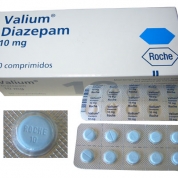Diazepam (Valium)

Description
Diazepam belongs to the benzodiazepine group of drugs, which can be broadly described as ‘depressant’ drugs in that their various clinical effects are in contrast to those produced by stimulant drugs.
It has several main clinical effects –acting as: a sedative; a hypnotic (sleep-inducer); a muscle-relaxant; a potent anxiolytic (anti-anxiety drug) and an anti-convulsant (mainly for acute seizures rather than epilepsy management). Diazepam may also be used to assist alcohol/ opiate withdrawal and during traumatic surgical procedures as it also possesses amnesic properties. These multiple effects make diazepam a useful drug in alleviating a wide-range of medical conditions.
In its natural state, diazepam consists of white or yellow solid crystals that are odourless but have a slightly bitter taster. It is usually supplied in tablet form (2mg, 5mg and 10mg strengths in the UK) while injectable, intra-venous (IV) and suppository forms are mainly reserved for use in acute clinical settings where a rapid onset of action is normally required.
Despite its usefulness, the problem of diazepam users developing a tolerance to the drug coupled with its inherent addiction potential have led to a tightening-up of clinical supply to minimise the harm these problems cause. That said, other avenues of supply such as clandestine production and sales from people who have been prescribed the drug for themselves continue to exist and grow in number. Besides addiction/ dependency problems, non-clinical diazepam usage includes combining it with other depressant drugs (including alcohol) to enhance the sedating effect and using it after stimulant drug use in order to have a more gentle ‘come down’. Diazepam is also frequently used in intentional overdoses, although this is often in combination with other drugs.
